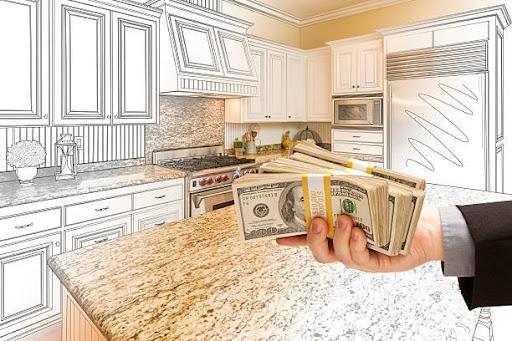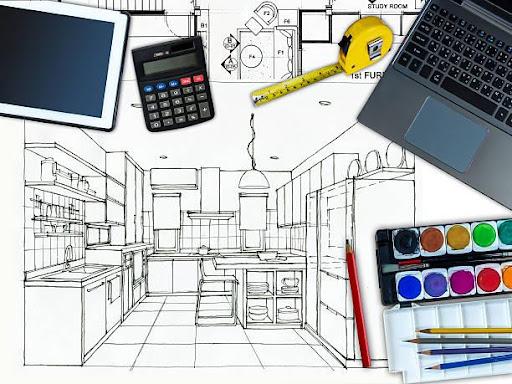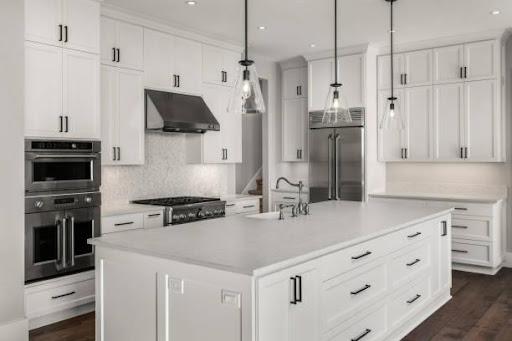Kitchen Addition Cost
It’s no secret that a kitchen addition is a big job. Neither is it a secret that most people do regard their kitchen as the heart and soul of their home. However, because the addition project has so many aspects, almost anyone may tailor it to their specific needs.
While the average cost of a kitchen addition is roughly $40,000, this cost guide will show you how to save money while designing your dream kitchen.
How Much Does a Kitchen Addition Cost?
On average, a kitchen addition costs between $25,100 and $40,000. This lower price range refers to a conventional 10×10 kitchen with low- to mid-range fixtures. A premium kitchen will cost $100,000 or even more.
Greater-priced appliances and more square footage are included in the higher price. When it comes to gourmet kitchens, the most expensive items are high-end appliances, countertops, and fixtures.
These figures may appear high but any kitchen makeover addition is dependent on many factors. The good news is that if certain tasks are not necessary your kitchen addition could cost half of what’s indicated above.
These actions can include demolition, plumbing or even putting in new electrical wiring. If you also have a small kitchen, your kitchen addition could also cost you less. The average homeowner spends $75 to $250 per square foot on kitchen additions. (Home Guide, 2021)
ProTip Takeaway: You’re probably trying to have a kitchen addition on a budget. The best way to save money is to make sacrifices or adjustments to your budget in other areas. These include avoiding high-end or smart appliances.
Kitchen Addition Cost Breakdown by Feature
Estimates might be helpful when it comes to kitchen additions. Knowing how different kitchen equipment costs will help you budget for your addition. However, the cost of each job will likely vary substantially. Here’s how much you can expect to pay for a kitchen addition:
Countertops: $825 to $3,850
Upgrading your countertops will not only improve the look of your kitchen but also increases the value of your home. According to HomeAdvisor, installing countertops during a kitchen addition can increase the value of your home by 25%.
ProTip Takeaway: Real estate agents advise against using loud or flashy countertops as these do not sell a home faster. A more neutral-colored natural stone countertop is timeless and more appealing.
Kitchen appliances: $320 – $4,030
If you’re considering a large kitchen addition, map out the new kitchen layout first to guarantee that the kitchen appliances you buy will fit. Kitchen addition appliances can include dishwashers, sinks, faucets, refrigerators, microwaves, and ovens among others.
Some homeowners today choose to install smart kitchen equipment or those that are environmentally friendly. They tend to be more expensive, but eco-friendly solutions, in the long run, do help you save money on your energy bills.( Angi, 2022)
ProTip Takeaway: Look for open box discounts and clearance markdowns at your local box shop if you’re seeking a great deal. You can also keep a lookout for manufacturer refunds, which can help you save money.
Plumbing: $200 – $3,000
New plumbing is extremely important for mid-range and major kitchen additions and even remodels. This will include the replacement of outdated sinks and faucets, as well as the addition of necessary pipes if the layout is being changed. The cost can range anywhere from $200 to $3,000 or more.
ProTip Takeaway: It’s difficult to give a precise price without understanding the scope of the plumbing work required. As it is with many jobs you first have to consult a professional to get the exact cost.
Storage Cabinets: $2,000 – $30,000
A crucial component of any kitchen addition is new cabinets. The addition of new kitchen cabinets can cost anywhere from $2,000 to $30,000 or more. This is all dependent on how much storage you need and the materials you choose. Cabinets made of wood can cost you from $5,000 to $25,000 on average. On the other hand, stainless steel cabinets can cost anywhere from $25,000 to $38,000.
ProTip Takeaway: Removing your old cabinets as a DIY project will save you money on labor.
Flooring: $1,000 – $4,000
A kitchen addition can also include new floorings such as new laminate or tile floors. This might cost anywhere from $1,000 to $4,000 depending on square footage. You can also consider some budget kitchen floor ideas that could help you save money.
Lighting: $500 – $2,000
For improved cooking and functionality, many kitchen additions include adding new ambient lighting. In and under-cabinet lights are a delightful addition to your kitchen if you have a higher budget. Lighting additions can start at $500 and can go up to $2,000.
Paint: $900
A new paint job during a kitchen addition will unify your kitchen and complement your installed appliances and worktops. Painting a 150- to 250-square-foot kitchen costs around $900.
Labor and installation: $3,500 – $6,000.
Labor and installation might account for 25% to 35% of any kitchen addition, according to HomeAdvisor. The entire project labor cost is influenced by location, the type of equipment being installed, and the size of your kitchen. (Homelight, 2021)
ProTip Takeaway: It is a good idea to factor in $2,500 in installation costs for every $10,000 you expect to spend.
|
Kitchen Addition Feature |
Cost Estimate |
|
Countertops |
$825 to $3,850 |
|
Kitchen appliances |
$320 – $4,030 |
|
Plumbing |
$200 – $3,000 |
|
Storage Cabinets |
$2,000 – $30,000 |
|
Flooring |
$1,000 – $4,000 |
|
Lighting |
$500 – $2,000 |
|
Paint |
$900 |
|
Labor and installation |
$3,500 – $6,000. |
What Influences the Cost of a Kitchen Addition?
Each kitchen addition project is unique and based on the homeowner’s vision. There are three elements that might help you estimate the cost of your addition project.
Size of the kitchen
The cost per square foot of a kitchen addition varies substantially, often ranging from $75 to $250. Carrying out a kitchen addition in a small kitchen may cost $10,000 less than a mid-size or big kitchen. This is because a small kitchen requires fewer cabinets and counters.
Quality of the Materials
Countertops, flooring, backsplashes, and cabinets can all be made from a variety of materials. High-end materials like mahogany cabinets might cost much more than less expensive alternatives.
Costs of Labor
The cost of your kitchen design will vary, but a reasonable rule of thumb is to budget for 25% of the entire cost of your addition. As stated earlier, factor in $2,500 in installation costs for every $10,000 you expect to spend. (Houzz, 2019)
How to Save Money During a Kitchen Addition
Paint the cabinets yourself
You will spend about $200 to $600 if you take up the painting job as a DIY depending on your supplies. You can also hire a pro for $400 to $1,550 on average.
Choose a low-cost tile
You can never go wrong with the all-time classic white subway tiles. The market has many affordable tiles such as the self-adhesive peel and sticks tiles for a few bucks per square foot.
Install a budget-friendly countertop
For $75 to $150 per square foot, you can buy and install countertops made of Formica or butcher block that will still look great in your kitchen.
Maintain the current kitchen layout
To save money on plumbing, electrical, and structural repairs, stick to your kitchen’s original plan. A new plan will result in the demolition and installation of new plumbing and electrical, all of which will cost more money.
Mix high-end and low-cost materials
The greatest kitchen addition designs smoothly blend high-end materials with lower-end pieces. You can easily save money on hardware, faucets, and lighting fixtures. Doing this will allow you to focus on high-quality cabinets and countertops to attract buyers.
Plan and Save for unexpected costs
It is advisable to always set aside 15% to 20% of your budget for unexpected costs. You can encounter surprises like water damage, electrical issues, or other budget-busting surprises.
Stick to your financial plan
Sticking to your game plan (and budget) as the kitchen addition progresses is extremely important. Adding extras or features to your budget can quickly balloon your budget. This can in return cause a cascade of rising costs. (HGTV, 2021)
The Return on Investment (ROI) of a Kitchen Addition
A modern kitchen addition if your house is on the market, or are planning to sell it in the future is a great strategic move. This is because buyers are more eager to buy when the home has modern functional equipment.
A recently finished kitchen is also one of the determining aspects for 80 % of purchasers in the market when it comes to selecting and valuing a home.
The average return on investment (ROI) for a mid-range kitchen addition is between 50% and 60% of the total budget spent. For example, if you spend $69,000 on a kitchen addition, you may expect to return between $34,500 and $41,400.
If you choose to have a smaller kitchen addition, you can expect a return on investment of 75% to 80%. If you spend $24,000, for example, your recoup would be between $16,800 and $19,200.
The estimated return on your kitchen modifications will also be influenced by your location. The average return on investment for a kitchen addition in Houston is 60% to 80%.
Are you ready to get started on your kitchen addition project?
You probably have questions about what costs you’ll need to budget for or where your home will stand in terms of ROI after a kitchen addition. Meeting with an industry professional is a good place to start.
Smart Remodeling based in Houston, Texas is the best company to help you with any questions that you may have. We have been assisting clients in making their remodeling projects a success and we can also assist you too. For a free consultation, please contact us today.








